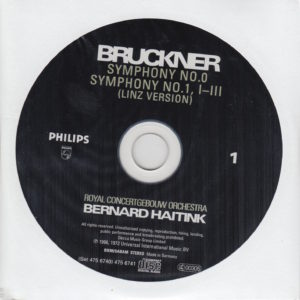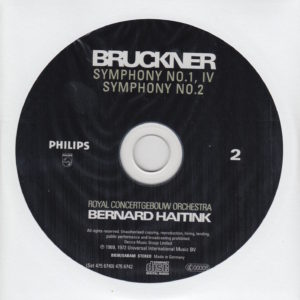 This morning’s conductor of Anton Bruckner’s Symphony No. 1 in C Minor (WAB 101) is Netherlands-born Bernard Haitink (1929-), who conducted his first concert in 1954. Haitink’s entry on Wikipedia tells us he has something in common with another conductor I’ll be listening to very shortly:
This morning’s conductor of Anton Bruckner’s Symphony No. 1 in C Minor (WAB 101) is Netherlands-born Bernard Haitink (1929-), who conducted his first concert in 1954. Haitink’s entry on Wikipedia tells us he has something in common with another conductor I’ll be listening to very shortly:
His conducting debut with the Concertgebouw Orchestra was on 7 November 1956, substituting for Carlo Maria Giulini. After the sudden death of Eduard van Beinum, Haitink was named first conductor of the Concertgebouw Orchestra on 1 September 1959. He became principal conductor of the Concertgebouw Orchestra in 1961, and shared that position jointly with Eugen Jochum until 1963, when Haitink became sole principal conductor. With the Concertgebouw Orchestra, Haitink made many recordings for the Philips label, and later Decca and EMI Classics, and toured widely with the orchestra.
Eugen Jochum is also known for his work with Anton Bruckner. I’ll be listening to Jochum tomorrow.
Haitink, like other conductors before him (Barenboim and Schaller) in my 144-day project, chose the Linz (1866) version of Bruckner’s Symphony No. 1 in C Minor (WAB 101). And, to quote Robert Frost, it has made all the difference.
Also, like Barenboim, Haitink has ties to the Chicago Symphony Orchestra.
 But today is all about Bernard Haitink.
But today is all about Bernard Haitink.
His orchestra for this recording (which was made in 1972) is the Royal Concertgebouw Orchestra. So far, this is the oldest recording to which I’ve listened in my Bruckner project. The record label is Philips. Bruckner was 41 when he composed this symphony. Haitink was 43 when he conducted on this CD.
Yet, despite the age of this recording (44 years!), this is bright, rich, and clear. It’s a very fine recording of a very fine performance.
In fact, this is my favorite so far. I thought Barenboim and Schaller (especially the latter) would be the conductors to beat. But Haitink’s interpretation just leaped ahead of them.
 Before I get to the objective aspects of this performance, I have to say that I was surprised to see that the makers of the Haitink Bruckner box set chose to split Symphony No. 1 onto two CDs. I kid you not. Movements I, II, and III are on CD 1. The Finale was broken off and placed on CD 2.
Before I get to the objective aspects of this performance, I have to say that I was surprised to see that the makers of the Haitink Bruckner box set chose to split Symphony No. 1 onto two CDs. I kid you not. Movements I, II, and III are on CD 1. The Finale was broken off and placed on CD 2.
That’s really stupid. It totally interrupts the flow of the Symphony, relegating the listening experience an obvious second to expediency. In fact, as I’m typing this, I have iTunes on repeat – as I do every morning when I listen to these symphonies and type these blog entries – and I just realized I skipped over the Finale and I’m back to listening to Allegro, Movement I.
Once I realized I’d missed the Finale, I clicked on CD 2 to listen to it. But, by then, I’d already missed its natural place in the flow.
I can remedy this situation in iTunes by creating a Playlist that contains three tracks from CD 1 (Allegro, Adagio, and Scherzo) adding to them track 1 from CD 2 (Finale). That enables me to hear the entire symphony the way it was intended to be heard: start to finish.
I certainly hope other box sets in my Bruckner project don’t resort to this. It may save money by enabling the label to stuff as much on each disc as possible (thereby not having to manufacture an additional disc). But it’s a terrible thing to do to the customer who’s trying to enjoy the music.
The saving grace in this instance is (a) the quality/performance of the recorded music, and (b) the CD liner notes.
The liner notes include an essay titled “I Take Refuge In Strength and Write Powerful Music: Thoughts on Anton Bruckner,” by Jorg Peter Urbach.
It’s a superb essay, quite readable, fun, and informative. For example, this:
This then is Anton Bruckner – a name which seems to inspire reverence. People tend to whisper it when they find it on a concert programme announcing one of his works. Usually it stands alone there – with one symphony. Nothing else. For his works are too weight, too enigmatic to be placed alongside other work, which would anyway be no more than makeweights [perhaps the essayist means lightweights]. He stands alone there.
Let us go back to the year 1874. What was there to do for Bruckner, a man without ties? He laid stress on his “urge to compose, which [he] had felt passionately for many years” now, and he sought salvation in his music. “I take refuge in strength and write powerful music,” he wrote in 1874, thereby throwing light on his situation at the time he was composing the first version of the Fourth Symphony. Was Bruckner insecure and a waverer? Many assume so. Did he have any character at all? Many doubt it. Yet reading the statement again makes one feel that this irresoluteness on the composer’s part, which was apparently becoming notorious, this latent vulnerability to his surroundings, actually reveals a secret insight into the world about him. Bruckner was indeed insecure in the everyday world; no one can maintain otherwise. But in music, in his music, he was a man of power…
That offers insight into Bruckner’s character that I have not read before.
Okay. Now for the objective aspects: The running order for this symphony under Haitink’s hand.
Bruckner wrote his symphonies in four parts. The breakdown of this one (1866 Linz version), from this particular conductor (Haitink) and this particular orchestra (Royal Concertgebouw Orchestra), is as follows:
Allegro…………..12:09
Adagio……………13:07
Scherzo……………8:51
Finale……………..12:47
The running order for the Barenboim performance of Symphony No. 1 (Linz version) was:
Allegro…………..12:19
Adagio……………12:12
Scherzo……………9:06
Finale……………..13:28
The running order for the Schaller performance of Symphony No. 1 (Linz version) was:
Allegro…………..14:12
Adagio……………12:52
Scherzo……………8:59
Finale……………..15:32
As you (whomever “you” are) can see, the Barenboim performance was the longest. He aired out the Finale by some two full minutes, and he even stretched the Allegro Movement I by two minutes.
The Haitink performance is the shortest of the three conductors who relied on the Linz version. Haitink’s version of Symphony No. 1 is taut and expressive. It’s interesting to note that Haitink stretched out the Second Movement (Adagio) nearly a full minute longer than Barenboim did, and about 15 seconds longer than Schaller did.
The last :60 of Adagio restores the delicate sense of awe and wonder that was missing from the previous conductor’s performance. The lyrical gentleness of those final :60 seconds tells me that Bruckner was nothing if not an emotional soul.
It’s also interesting to note that, according to Bruckner’s entry on Wikipedia,
Bruckner gave it [Symphony No. 1] the nickname “das kecke Beserl”, roughly translated as “saucy maid”.
“Saucy Maid,” which is how iTunes lists these tracks, is deliciously wicked. One blogger, an insightful fellow named Alan Beggerow, on his expansive site Musical Musings, posted this about Bruckner’s Symphony No. 1:
He worked for over a year on it, writing and rewriting, sometimes scrapping entire movements and beginning over. He finished the score in August of 1866, fifteen months after he had begun. Bruckner gave the symphony a nickname, das kecke Beserl, which is Austrian slang and roughly translates as ‘the saucy maid’, perhaps because of the spirit of the symphony, or perhaps for some other reason that we’ll never know.
Indeed. Perhaps we’ll never know.
By the way, here’s a fine interview on the ABruckner.com site with Dutch Bruckner scholar Cornelius van Zwol who also mentions the Saucy Maid, albeit in passing at the very end of the interview. van Zwol paints a different picture of Anton Bruckner from what I’ve read to this point. The interview is definitely worth a read.
And all of this brings me to my rating for Haitink’s performance this morning.
My Rating:
Recording quality: 4 (only slight tape hiss audible)
Overall musicianship: 5
CD liner notes: 5 (includes a very fine essay)
How does this make me feel: 4
Haitink’s rendering of Bruckner’s Symphony No. 1 in C Minor is taut, lively, rich, bold, and stirring. I would have given this box set’s Symphony No. 1 fives across the board if not for two things:
1. The unfortunate, shortsighted splitting of Symphony No. 1 onto two CDs, and
2. A playback anomaly at the tail end of Movement III that sounds like an error on the CD itself. There’s a digital tick, tick, tick sound in the last 20-30 seconds of this track. I’ll re-rip the CD into iTunes to see if it goes away.
Haitink’s Movement IV (Finale), alone, is worth the price of admission. This is one of the most muscular recordings I’ve ever heard of a Bruckner movement. Very dynamic. In your face without being brash. Very expressive.
I feel like standing at attention after hearing Haitink’s interpretation of Bruckner’s Finale.
And his Movement I (Allegro) was a close second in its ability to stir my soul.
Well done.
Very well done.
I really hope that ticking at the end of Movement III was just an anomaly that occurred when copying the CD to my laptop hard drive. If not, it’s a defect in the CD mastering.
